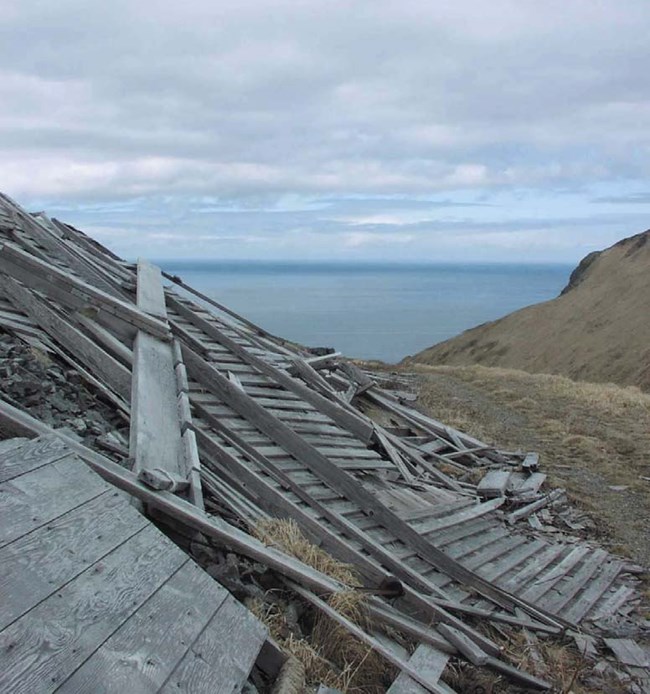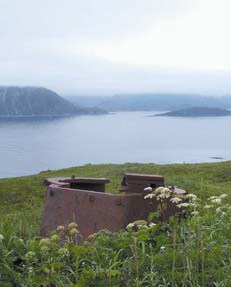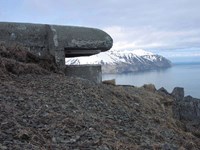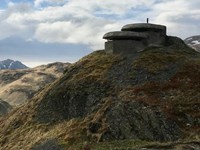
The Iron RingThe many strategically placed observation outposts and defense fortifications constructed along the coastlines of Amaknak and Unalaska islands during World War II formed what was known as the “Iron Ring.” Anti-submarine nets strung across Iliuliuk Bay and Captains Bay were also part of this coastal defense system. The two largest coastal defense fortifications were Ulakta Head Battery 402 at Fort Schwatka and Eider Point Battery 298 at Fort Learnard. 
Fort Schwatka/Ulakta Head Coastal Defenses (1942-1944), Amaknak IslandFort Schwatka and Battery 402, constructed during 1942-1944, was the center point of the coastal defense system. At the top of Mount Ballyhoo overlooking Unalaska Bay, Ulakta Head is the northernmost point of Amaknak Island. This defense battery is 897 feet above sea level, the highest battery in the United States. Fort Schwatka and Battery 402 at Ulakta Head form the Aleutian World War II National Historic Area.Artillery at Battery 402 consisted of two 8-inch guns. Artillery support structures included the concrete Harbor Defense Command/Harbor Defense Observation Post, shell and powder magazines, a generator room and a radio room. The plotting room was below ground, connected by a tunnel to the Observation and Command Post. Fort Schwatka provided housing and support services for the men of Battery 402. Some of the buildings, such as the barracks and warehouses, were wood frame, but many others-the mess hall, PX, and supply and administration buildings-were Quonset huts. Although most of the concrete and steel structures at Ulakta Head are still standing, few of the wood-frame buildings and none of the Quonset huts at Fort Schwatka have survived 60 years of wind, rain, and snow atop Mount Ballyhoo. 
Fort Learnard (1942-1944), Unalaska IslandFort Learnard and Battery 298, accessible only by water, are located on the cliff above Eider Point, 4 miles directly west of Ulakta Head. Until a road was built to the top of the cliff, supplies were transported to the fort by means of a tramway. Housing and support services buildings were similar to those constructed at Fort Schwatka and Hill 400. Only a few of these buildings remain intact due to the harsh Aleutian climate.A 492-foot-long underground tunnel provided access to the two 6-inch guns at Battery 298, which were set into pits, protected by large steel shields, and camouflaged by netting. Behind the guns was a battery magazine of reinforced concrete. The battery magazine and the gun shield remnants at Fort Learnard are still in relatively good condition, but only traces of the tunnel remain. The access road up the hillside to Fort Learnard is on private property, and the land at Eider Point is owned by the Ounalashka Corporation. 
Courtesy National Archives, Pacific Alaska Region. Dutch Harbor Naval Operating Base“Every station, office, and activity ashore exists but to serve the NAVY AFLOAT, UNDER THE SEAS, OR IN THE AIR.” (War Diary, Dutch Harbor, Alaska).Dutch Harbor Naval Operating Base was constructed as a naval air station in 1940-1941, at a deep-water port on Amaknak Island used for centuries by the Unangan people and Russian fur traders. As the diary entry above proclaimed, the base provided a landing field and weather data for pilots and also repaired, refueled, and reprovisioned the submarines and other U.S. ships that patrolled the Bering Sea and Pacific Ocean. Some of the remaining defense fortifications of the Naval Operating Base can be seen on the lower slope of Mount Ballyhoo, just north of the airport runway. These structures include earthen revetments, which shielded aircraft from enemy fire and the Aleutian wind, and concrete munitions-storage magazines. Tall concrete blast walls protected the entrances to many of the magazines. 
Courtesy National Archives, Pacific Alaska Region. Fort MearsFort Mears, named after Colonel Frederick Mears, was established to defend the Dutch Harbor Naval Operating Base. The fort was constructed during 1940-1941 on the narrow strip of land between Margaret Bay and Unalaska Bay, the only flat terrain on Amaknak Island. After the construction of Fort Mears was underway, defense installations were also built at Hill 400, Mount Ballyhoo, Eider Point, and Summer Bay.The photograph above shows wards of the 250-bed hospital at Margaret Bay. In addition to treating injuries from training exercises, construction accidents, and rat bites, the hospital also treated men who contracted diseases such as pneumonia, mumps, and German measles. The nurses at Fort Mears Hospital, the Naval Air Station Hospital, and the field hospital in Pyramid Valley were the only women stationed at Dutch Harbor during World War II. Plan Your VisitShowing results 1-1 of 1
Loading results...
Explore In-DepthShowing results 1-9 of 9
Tags:
wwii aleutian islands
|
Last updated: August 8, 2024









